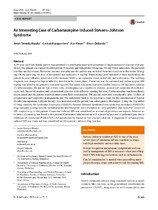| dc.description.abstract | A 29-year-old Black female patient was admitted to a psychiatric ward with symptoms of major depressive disorder with psychosis. The patient was started on amitriptyline 50 mg/day and haloperidol 10 mg/day. On day 4 post-admission, the preferred first-line antidepressant, fluoxetine, became available and the patient was switched from amitriptyline to fluoxetine 20 mg/day. On the same day, the dose of haloperidol was reduced to 5 mg/day. Thirteen days post-initiation of these medications the patient became talkative, associated with emotional lability, an expansive mood, irritability and restlessness. The working diagnosis was changed to bipolar affective disorder in the manic phase. Fluoxetine was discontinued and carbamazepine 600 mg/day was added to the patient’s treatment regimen. Her manic symptoms started to resolve; however, 14 days post-initiation of carbamazepine, the patient had a fever; itchy, discharging eyes; respiratory distress; generalised symmetrical erythematosus rash; buccal ulceration; and conjunctival injection with difficulty opening her eyes. Carbamazepine was immediately discontinued and the patient received intravenous fluid resuscitation. The patient recovered considerably after 12 days of symptomatic and supportive management, and was transferred back to the psychiatric ward for the continuation of bipolar disorder management. Lithium therapy was instituted and the patient was subsequently discharged. Using the Algorithm of Drug causality for Epidermal Necrolysis (ALDEN) Stevens–Johnson Syndrome/toxic epidermal necrolysis (SJS/TEN) drug causality scoring system, carbamazepine and fluoxetine were evaluated as ‘very probable’ and ‘possible’ causes of SJS, respectively, in this patient. Fluoxetine-induced SJS was considered on account of previous case reports, however no evidence of causality was found in this patient. Consecutive administration with a potential increase in carbamazepine due to inhibition of cytochrome P450 (CYP) 3A4 metabolism by fluoxetine was also not ruled out. A diagnosis of carbamazepine-induced SJS was made and was considered an idiosyncratic adverse drug reaction. | en_US |

